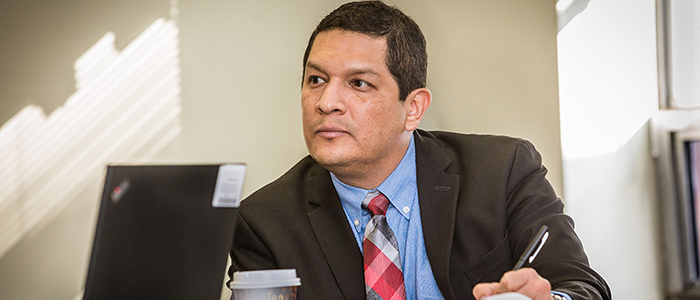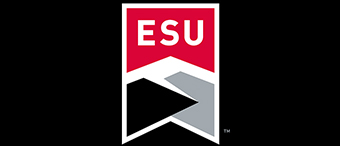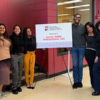Deputy Education Secretary Seeks ESU Input on Diversifying Teacher Workforce

Posted by: Elizabeth Richardson on March 15, 2019, No Comments
How can Pennsylvania attract more people of color to become teachers?
That was the question at the center of a meeting Monday, March 11 between two high-ranking officials from the Pennsylvania Department of Education and East Stroudsburg University faculty, administrators and two ESU doctoral students, who also lead a Lehigh Valley high school.
Children of color are expected to make up 56 percent of the student population nationwide by 2024, while the current educator workforce is about 82 percent white, according to the U.S. Department of Education.
Terry R. Barry, Ed.D., dean of the College of Education, told Dr. Noe Ortega, deputy secretary of education of Postsecondary and Higher Education, and Dr. Debra Heath-Thornton, director of the Bureau of School Leadership and Teacher Quality, that ESU is starting the Future Teacher Bridge Program in the fall as a way to recruit a more diverse pool of students to consider education as a career.
“It is something that is sorely needed across the Commonwealth and the nation for that matter,” Barry said. “That is: How do we effectively encourage minorities to enter the education field so they can go through this great program and then come out and impact students?”
The Bridge Program will offer 10 high school juniors and seniors the opportunity to take ESU’s Introduction to Teaching course free of charge, introducing students to the fields of Early Childhood Education, Middle Level Education, Secondary Education, Special Education and English as a Second Language. Participants will also be invited to join ESU’s Future Teacher Club.
Barry also talked about ESU’s Professional Development School for prospective teachers, which gets them into classrooms sooner and gives them more hours of hands-on experience.
Beth Rajan Sockman, Ph.D., professor and co-department chair of Professional & Secondary Education, said students of color are well aware that there few school teachers who look like them.
“They have said, ‘There’s not enough of us in education. There needs to be more of us out there,’” Dr. Sockman said.
Harrison Bailey III, principal at Liberty High School in Bethlehem and a candidate in ESU’s doctoral program in Educational Leadership and Administration, has seen that need firsthand, coming from a school that is 37 percent Latino and 14 percent African American.
His district is considering adding an education career pathway for students who can choose to concentrate on one of four areas – STEM; Arts, Humanities & Communication; Health & Social Services; and Business, Finance & Law.
“One thing I noticed that if you leave Liberty High School and you go into education, you come back to Liberty High School,” Bailey said. “We need to grab these students as freshmen and sophomores and say ‘You want to go into education and here’s why.’”
Ortega, a former kindergarten teacher, praised both the proposed Liberty High School education pathway and ESU’s Bridge Program as innovative strides to bringing more diversity into the field.
“The whole ‘Grow Your Own’ concept is a big one,” he said.
Barry advocated for state funds to pay for projects like the Future Teacher Bridge Program and incentives such as paying a portion of college tuition for students who commit to being teachers.
Bailey said some families of color try to steer their children away from the teaching profession because they fear their kids won’t make enough money to pay off their college loans and live comfortably.
“We know from a long-term prospective that education is an incredible place,” Bailey said. But, he said, “when you’re in a crisis, you’re not thinking about the long term. You’re thinking about how is my kid going to pay his bills when he gets out of college.
“If we’re serious about creating the presence of people of color in education, we have to change the narrative …. that education actually does pay.”
Heath-Thornton talked about the need for young people and their families to understand that teachers have opportunities for advancement.
There was wide agreement that the Commonwealth and the education profession have to do a better job of improving the image that society has of teachers.
“One of the biggest issues in getting high-quality teachers at the high school level is the stereotypes we face as educators,” Sockman said. “My chemistry majors receive ridicule from other chemistry majors and peers for going into teaching. That’s got to change.”
It’s also important to give education majors of all races a better understanding of the struggles that kids who live in poverty face every day. To that end, Brooke Langan, ESU director of field experience and partnerships, and Shawn Watkins, Ph.D., chair of the Reading Department, talked about how they have brought in staff from the nonprofit Pocono Alliance to run poverty simulations for education students so they will have a better understanding of what some kids grapple with at home.
Also weighing in on the conversation Monday were Caroline Dipipi-Hoy, Ph.D., professor of Special Education, Kathy Post, ESU assessment and accreditation specialist, and Amanda Hinkel, an ESU doctoral student and Liberty High assistant principal for curriculum and instruction.
Ortega liked what he heard.
“This was a fantastic conversation,” he said. “To hear the university shed light on things that they’ve been doing to diversify the educator workforce is phenomenal.”
“Pennsylvania has really struggled in terms of diversifying the field of education. We want to find ways to attract more teachers of color but we also want all teachers prepared for the challenges of the modern-day classroom.”




